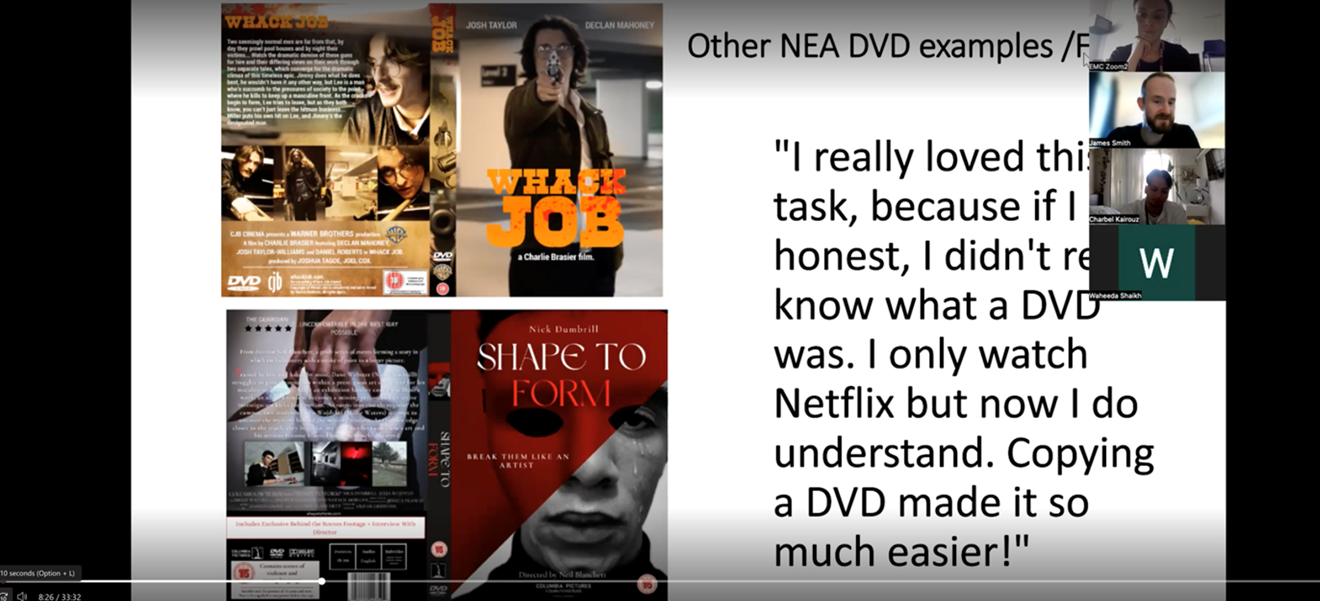As a follow up to our investigation into the value of low stakes practical tasks in media lessons, we met up with the same group of teachers again over zoom in Summer 2 to see if there was any long-term impact. If you haven’t already read our blog post about the first meeting, you can do so here.
We asked a series of questions to capture some of the teachers’ thoughts and reflections about the long-term impact of using low-stakes practical tasks; on the students, on the teaching practice of the participants and on the NEA.
Impact on students
All participants reported a positive impact on students. This expressed itself in several ways:
- Students approached the NEA with more confidence.
- Students had the technical skills they needed for the NEA.
- Students were more ahead with their research, planning and production and more independent than previous cohorts.
- Students were more active and engaged in lessons.
- Students seemed to understand theories better.
- Some students used their new skills outside media lessons, creating marketing materials for the sixth form open evening and for student elections. Raising the profile of the subject around school.
- Students were very positive about the practical tasks.
- Students were better able to understand and remember the conventions of media forms as a result of doing low-stakes practicals where they had to recreate an existing media product.

Impact on teaching practice
All participants said that low-stakes practicals had changed the way they thought about and planned their lessons.
- Jenny talked about the fact she now tries to use low-stakes practicals as often as possible even just as a starter task or at the end of a double lesson as way of applying the theoretical ideas that students have learnt in the main part of the lesson. She also spoke about the importance of getting students to use their phones in lessons about media language.
- Charbel explained that he uses low-stakes practicals as a strategy to help students who struggle with writing. This is because low-stakes practicals give students who struggle with writing the opportunity to experience success as they are able to show their understanding in a different way. Similarly, James reported that he gets students to use their production work when writing up their ideas because then they have something tangible in front of them to represent the idea or concept – the practical task acts as a scaffold for writing.
- James also explained that he uses low-stakes practicals because it is a great way of assessing the learning. He said it provides solid evidence that learning has taken place. He also spoke about new cohorts of A-Level Media students being very quiet and unwilling to speak in lessons and that practical work has helped to bring energy back into the classroom.
- Sarah talked about the fact she now tries to make Media distinct from other subjects like English or Sociology by bringing in low-stakes practicals at the start of the course as homework tasks like video essays or making an infographic on Canva. Students tend to be unfamiliar with this way of doing things at first. However, after a short time, Sarah reported that they suddenly begin to ‘default to production work'. Sarah said she was working on building a library of workshops/ low-stakes lessons she can dip into throughout the year.
- Waheeda spoke about using low-stakes practicals to revisit a topic students were less confident about. She also spoke about practical tasks making the learning really memorable. When planning her Media GCSE units of work for next year, Waheeda talked about making sure there were lots of low-stakes practical tasks because she feels confident that this will help students be more independent by the time they arrive at the NEA.
When reflecting on the impact of the project overall, all participants spoke about the importance of production and creativity in Media Studies as a subject.
When discussing some of the challenges teachers might face, participants spoke about having enough time, anxiety among colleagues or leaders that these tasks might not be robust enough as ways of assessing the learning because they are, perhaps, less formal than writing a paragraph. Sarah said there might be behaviour concerns when students used their phones. Charbel and James both spoke about the need to convince other teachers that low-stakes practicals were a valuable use of class time. James suggested that one solution might be to remind leaders or colleagues that students learn industry standard skills in Media and that it offers students much more than good grades because it teaches them how to be industry ready. However, all participants reflected that despite these challenges they would be continuing to embed low-stakes practicals in their teaching going forward.
It's been fantastic to hear how enthusiastic the teachers were when talking about using low stakes practical tasks in their lessons and we hope the feedback above leads to more Media teachers using these strategies.
If you’re interested in low-stakes practical work, then you can watch our free Twilight CPD video here. Please do get in touch if you’re thinking of trying out some activities, or if you already have. We’d love to hear from you! The Media team at EMC are working on collecting a library of resources of ready-to-use low-stakes practicals for both KS4 and KS5 Media lessons. Watch this space.





